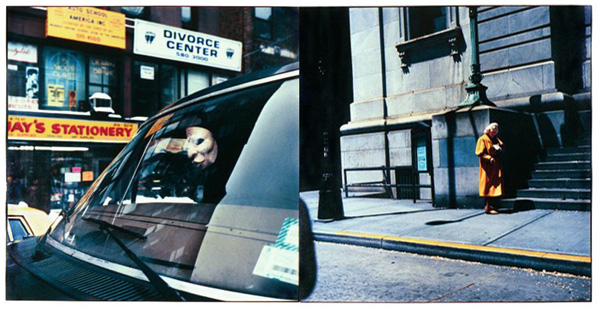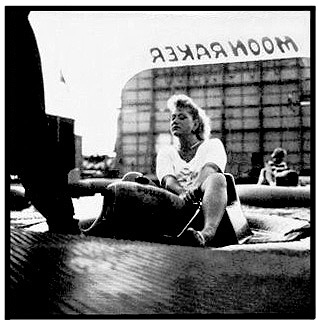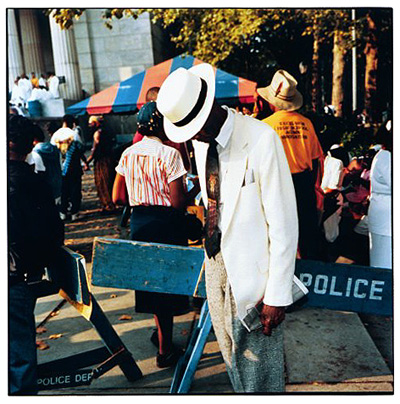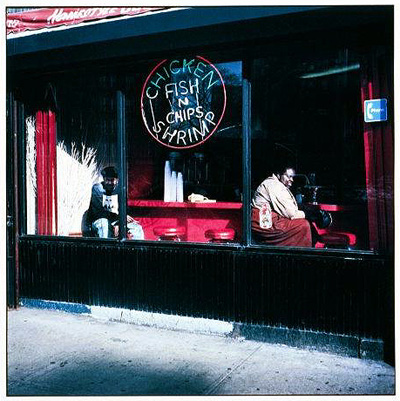| Himes
immaculately unmakes
us still, with these words from over twenty years ago, even more true
today,
more damaging. Now we are being forced by all that is good and evil, to
engage in the same rigorous atypical thinking he stepped in here, so
that
we might free ourselves from our own demons, freer to then deal with
how
theirs
become
ours.
We know its hot in here, that it's not just us and we know what's not
to
like.
America is having black spasms, so we are feted with a rogue's grostesquerie of new inhumanities and laying for each other; we communicate with the backs of our hands. The cognitive dissonance of whiteship itself, stuns; all-encompassing and ever-expanding as it is. That a waterhead like O.J. could shift their racial disorders into overdrive so completely, is dizzying, but not really surprising. O.J.'s image as one of the good ones was his so highly successful commodity, that when whites lapped him up, literally, it was simply to our miserable black detriment when he fell down through their cracks. Though we've been dragged down with him into this bacchanal of white indignation, we must persevere. Here in the Invisible Man's shadow, we are already given something of his substance, his heft. He casts it alone, the Ho Bitch/ Strong Black Woman dutifully fading into the blackground, by Million Mandate. The Invisible Man is in again, Visible, describing himself and his connections to the rest of us. There from his rather thrilling isolation, he seems timely, his hot water a little fascinating. In 1990's zero-sum declaratives, crazy-cool or wack-corny, we may still rediscover through him some of the reasons we are gathered here together, throwing the remnants of a civilization. Historical instances of Visible Man are typically coupled with a national seizure of ill regard for homo negro Americanus, and as Chester Himes so eloquently illustrated above, we are not just carriers, we are also infected. Thankfully, there are (cultural) doctors in the house (artists), who are called to do (interpret) now, what it is (we) they (must) do. Romare Bearden said of them, In Grant's Tomb, a bent, fine older gentleman, in a white suit and hat, is captured in a genuflective pose. He may be receiving ablution against its coincidental palette. The red and white striped blouse of a bystander mans the blue vector of the police barricades, neurotic/patriotic. The triangle of the vendor's umbrella gathers the crowd into its blue and orange affirmation. An epiphany of angels clothed in white, frolic in the top left, atop the tomb's steps. His spine strains against the grounds of the sepulcher."So it must be with the Negro artist- he must not be content with merely recording a scene as a machine. He must enter wholeheartedly into the situation which he wishes to convey. To be concerned with photography professionally, is an outrageous non-white career move, only slightly because of the increase in black males competing for the same apartheid jobs. Aside from Renee Cox, there are still virtually no visible freelance commercial black women photographers. Roy de Carava, an American Master, said of his own ride on this roller coaster, nearly forty years ago, Now there are tens to hundreds like him, like the Master, leading hand-to-mouth, unassigned existences; so many that if they were laid end-to-end, it might be even easier to step over them, as many accused curator Thelma Golden of doing, in her highly criticized "Black Male Representation" group exhibition at the Whitney."It was a horrible experience. I had won a Guggenheim. I had published a book. I had run a gallery, but I couldn't get any assignments. It was a hand-to-mouth existence."3 Reflecting Golden's post-modern/conceptualist palate, traditional documentary or free-standing photography was disregarded, in favor of the incorporation of camera work as a component of multi-media constructs. Her choices evoked something critic Gene Thornton noted in a 1982 essay about P.H. Polk, that 'art in the modern art world, to be accepted, must be about art'4 [my italics]. A dozen years later, the 'black male representation' at the Whitney was so post- modernized, conceptualized and martinized, they either failed miserably, succeeded beyond measure, or both, which is what the PoMos do so well, after all. Pardon my deconstruction, but the verb represent, in youngspeak, circa 1995, NYC, means to stand up for yourself, fight; represent! In which case, NASA-like, we have ignition. Virtually none of the established traditionalist black photographers known for bodies of work exploring black male images, were invited to participate. The resultant percussion of aesthetic, appropriation, sexuality, ideology, race and betrayal (!) was exhilarating and oddly inclusive; those who were not asked to contribute were still part of the scandalous event, if only by uninvitation. Sometimes, you can't lose for winning. We could surmise from Romare Bearden's directive, that the unincluded black photographers were closer to being bonafide quintessential Negro artists, than the Whitney Chosen; and one can even envision the black-attired PoMoCons smugly schmoozing through those hallowed portals, but that would be nonsense, even if it happened. Trads can't be rendered more artistically valid than the PoMo/Cons by writ of a nobler raison d'Ítre; if only because it has nothing to do with the work, which still matters. Two things: we are almost not here to fulfill each others' expectations, and the earth did not shatter when we didn't, even in our most shameless artful variances. It just seems that way because the Black Monolith does the hully gully whenever its confronted with diversity. When poet Melvin B. Tolson, another underlooked Master, published his epic Harlem Gallery: Book I, The Curator in 1965, similar issues of aesthetic, authority, racial identification, and betrayal were raised. In his introduction to Harlem Gallery, the fawning Karl Shapiro wrote, against a background of blarney and (well-intentioned) affronts, Tolson was compelled to counter the offensive introduction, published in his own book, later in an interview:"Tolson writes in Negro."5 Jennifer stands before us as white as can be, and unadorable, troubled. She holds herself clammily in her own arms, but it is the crimp in her precious mouth that makes our hearts leap out of our chests to her, because something has so obviously been stolen from her. Perhaps the thing that we traditionally set free as old teenagers, has been forced out of her prematurely. There is a strong cast of injury to her eyes, and in our head's afterimage of her, a tangible dampening of her light. Her environment is sinister and ragged and its shadows imprison. Jennifer does not have any of the Right Stuff around her. You want to pray for her."I hazard that Shapiro has pillaged my three books and discovered that I, as a black poet, have absorbed the Great ideas of the Great White World, and interpreted them in the melting pot idiom of my people. My roots are in Africa, Europe, and America."6 The PoMos and the Trads occasionally converge at claiming the place of America as our crucible, the kitchen of our nigger invention; part this, part that, and some a dat too. Still, on the high seas of Africentricity, sailed by some Trads and PoMos both, unblack references are verboten, constituting a denial ( a felony) of proud and loud African ancestry. Is you is, or is you ain't my baby? Arthur P. Davis asked rhetorically, regarding Tolson's Harlem Gallery, That, remarkably, in response to this:"How are we to take this strange work whose two main themes are art and the Negro? Is Tolson writing seriously or with tongue in cheek? Is he parodying, as one critic, Paul Bremen, suggests, the white man's concept of how a Negro putting-on-airs would talk?"7 is the art-fetish delivered from the black hole of the flesh by the mercy of the knife. The pride of the artist is the leach of green manure that slows down the sleet and snow and ice of an age's scorn.8 or (Mediterranean) of this race, of that time, of this place, of that psyche, with an Al Sirat of its own- and, beyond its bridge to Paradise, the ritual of light and shadow, idiom and tome, symbol and myth, pleasures the lover of Art alone in a bourne where no grapes of wrath are sown.9
The measure of art is purportedly in its power to exist in time. The measure of the modern African American is in their power to exist in their own time. The measure of the African American artist, is in their power to exist autonomously and authentically, despite the time. We are counterfeit, lighter emotionally and historically without the Trads, those who, as Bearden mused, surrender themselves in devotion to present day life. Nor should we discredit the subjective PoMo, whose work Tolson marvels, pleasures the lover of Art alone; we need us all.  So after
congratulating
Golden for swinging so hard on that icy old black monolithic, we can
also
acknowledge that the Whitney exhibition functioned exquisitely in
defining
what cleverness, otherness, conceptualism and the illustration of
stereotypes
could not say about cultural representation, particularly to
those
it only claimed to represent. And that art merely about art, at least
in
this case, was not enough- at the very least, to those whom
the
art was supposed to be about in the first place. Not only because I am
married to and collaborating with one of the Uninvited, of the Old
School,
please, let's break out the Invisible Man before he hurts himself:
I am an invisible man... I am invisible, understand, simply because people refuse to see me.
Homestyleis one of my favorite photographs in this collection. The woman at the counter speaks a definition of myself to me that is very funny and empowering. Sometimes I feel I am wrongly perceived as a big dark menacing woman, when I'm actually a big dark attractive woman. But sometimes the shoe just starts fitting, dependent upon the context, and I suddenly get to act a great deal more dangerous than my physicality should actually suggest. At these times, if I raised my hand and you flinched; I'd like it. I'd return all of your shit-eating grins with a glower. I'd stare at you silent when you said hello, I wouldn't notice you. I'd laugh later about your insecure writhes, to my big strong ugly friends, and we'd take up the whole fucking sidewalk on the way to Coota's Deli, and take two stools each when we got there. I like this color red immensely."...and somehow the African American male has emerged monstrous; lazy, morally weak, physically strong, oversexualized, and musical- yet monstrous nonetheless. Africa's descendants, male and female, became the only Americans collectively judged by their vilest (and overwhelmingly male) members. How we got to this point, all of us, is grotesque. For now we can no longer tell the enemy on sight, and no one is afraid to hate anymore."11 Neither American life nor the business of photography is as fathomable as it seemed back then; there was less an inevitability of awfulness. The shift to tiny CD boxes from the album cover underscaled the traditional commercial showcase of music portraiture and nearly eliminated the most consistently lucrative sector for those black men engaged in commercial freelance photography. Even more devastating, however, pop culture replaced romance with sex, conversation with television, and music video utterly stilled the inner musical adventure for young people. These aren't black or white phenomenon, but events we all suffer at the same time, as Americans.  The presupposed full nelson The Man has on a soul brother's reputation, disengages, with black men colluding so successfully in the entertainment industries now, in selling thuggishness, violence and misogyny. Just how much of the black male's PR damage is self-inflicted (or even deserved), and how much is reflective of the realities of his experience? Is the image of the black man for sale, and if so, why is there only one of the things, still? Can a humane interpretation 'sell', and to whom? If it seems like our male images are dominated by inarticulate, woman-hating, under-educated, post-adolescent, ne'er-do-wells, perhaps it's because they are. In that context, were Thelma Golden's curatorial decisions any different than say, the Notorious B.I.G.'s urgings to 'all the bitches in the house say HOOOOO-oooooH!'? Hose is such a marvelous use of penistry and class and prestidigitation, you can easily ignore the rolling satisfaction of the composition, with its earthly convex plane. There is some dotty consolation in this photograph, in the surreally stated unlevel playing field, coupled with the roundness of its world. We kind of teeter with it, toward our left, of course, up stream. Natural resources is part of the joke in the diptych, in the sense of pissing them away, which makes the piece multi-lingual, as well. Even if the Notorious B.I.G and Thelma Golden didn't have an actual conversation about image and black male representation, they said essentially the same things about each others' demographic, in their forms. "Bitches in the house say HOOOoooooH!!" is somehow equivalent to Thelma Golden's statement about Mike Tyson and the exhibition: "..he is my "Black Male!"12 Our solace is to remember how
remarkably
unimpaired the world seems, by the doings of the in
crowd.
Still, we not only won't get damp from beholding a waterscape, we can't
get 'caught' prying into our own intimate interiors. The treasure lies
in how subtly and permanently changed we are by having done so.
Bootsy's Room, this shrine to an Innocent Bystander is every bit as significant to Africania, to my funereal dregs, as The Tomb of the Unknown Soldier. Though he wasn't one himself, he was murdered by a South Central Los Angeles gang member. Bootsy was totally alive when he was, and his room is aglow with the phantasm of his prana as evidence. A mother's grief for her late son hovers intangibly in the frame, in its 'We kept it just the way he left it' look. We are safer here in Bootsy's room, than he was in our world. Melvin Beaunorus Tolson wrote, descend the tone ladder of a laughing goose, syncopating between the faggot and the noose; "Black Boy, O Black Boy, Is the port worth the cruise?" Like the lice and maggots of the apples of Cain on a strawberry tree, the myth of the Afroamerican past exacts the parasites fee. Sometimes the spirit wears away in the dust bowl of abuse, like the candied flesh of the barrel cactus which the unpitying pitch of a Panhandle wind leaves with unpalatable juice.13
When we Americanissimo, we most American, have the luxury to publicly and fully develop and fail as artists, and as human beings, without sacrificing ourselves in the process, without being niggered all the way down to the motherfucking ground; we shall be delivered. Black Boy,
©1995, 1996
by Meg Henson
Scales
Pictures From America
Footnotes:1 Chester Himes, The Quality of Hurt: The Autobiography of Chester Himes,Doubleday, 1972, pp. 285-862 Romare Bearden, The Portable Harlem Renaissance Reader, edited by David Levering Lewis, Viking Press, 1994, p. 141 (from The Negro Artist and Modern Art) 3 A.D. Coleman, Light Readings, Oxford Press, 1979, p. 25 4 Gene Thornton, "P.H. Polk's Genius vs. Modernism," New York Times, 2/21/82, pp. 25-26 5 Karl Shapiro, Introduction to M.B. Tolson's Harlem Gallery: Book I, The Curator, Twayne Pub., 1965, p.12 6 "Interview", Anger and Beyond, Harper and Row, 1966, p. 184 7 Arthur P. Davis, From The Dark Tower, Howard University Press, 1981, p.173 8 Melvin B. Tolson, Harlem Gallery: Book !, The Curator, Twayne Publishers, 1965, p. 96 (from Omicron) 9 Melvin B. Tolson, Harlem Gallery: Book 1, The Curator, Twayne Publishers, 1965, p. 99 (from Pi) 10 Ralph Ellison, The Invisible Man, Random House, 1952 11 Meg Henson Scales, Through Whose Eyes, 1989 12 Thelma Golden, transcript from NYO (New York Online) Chat with Thelma Golden, Feb. 14, 1995 13 Melvin B. Tolson, Harlem Gallery:Book I, The Curator, Twayne Publishers, 1965, p. 20 (from Alpha) 14 Melvin B. Tolson, Harlem Gallery:Book I, The Curator, Twayne Publishers, 1965, p. 153 (from Psi) |



